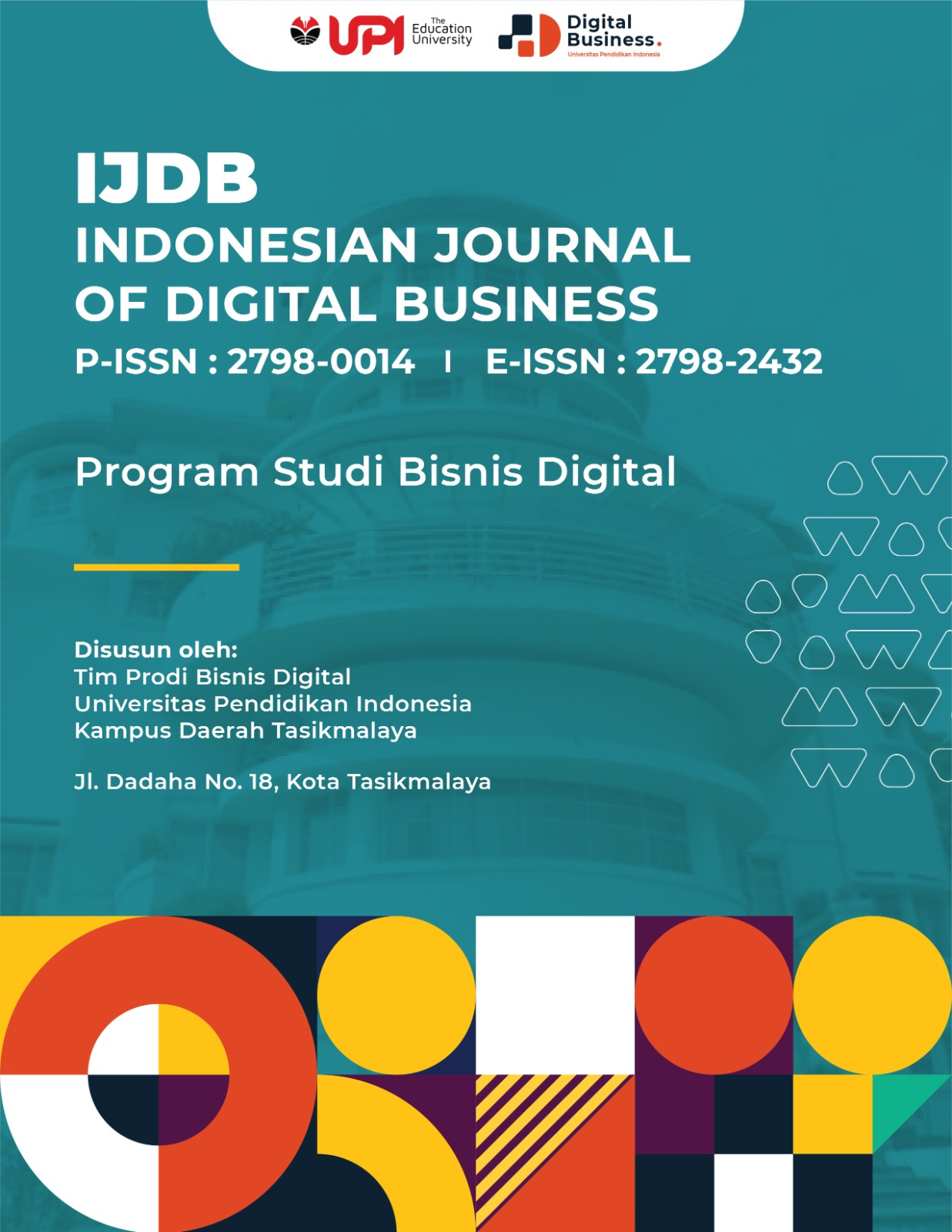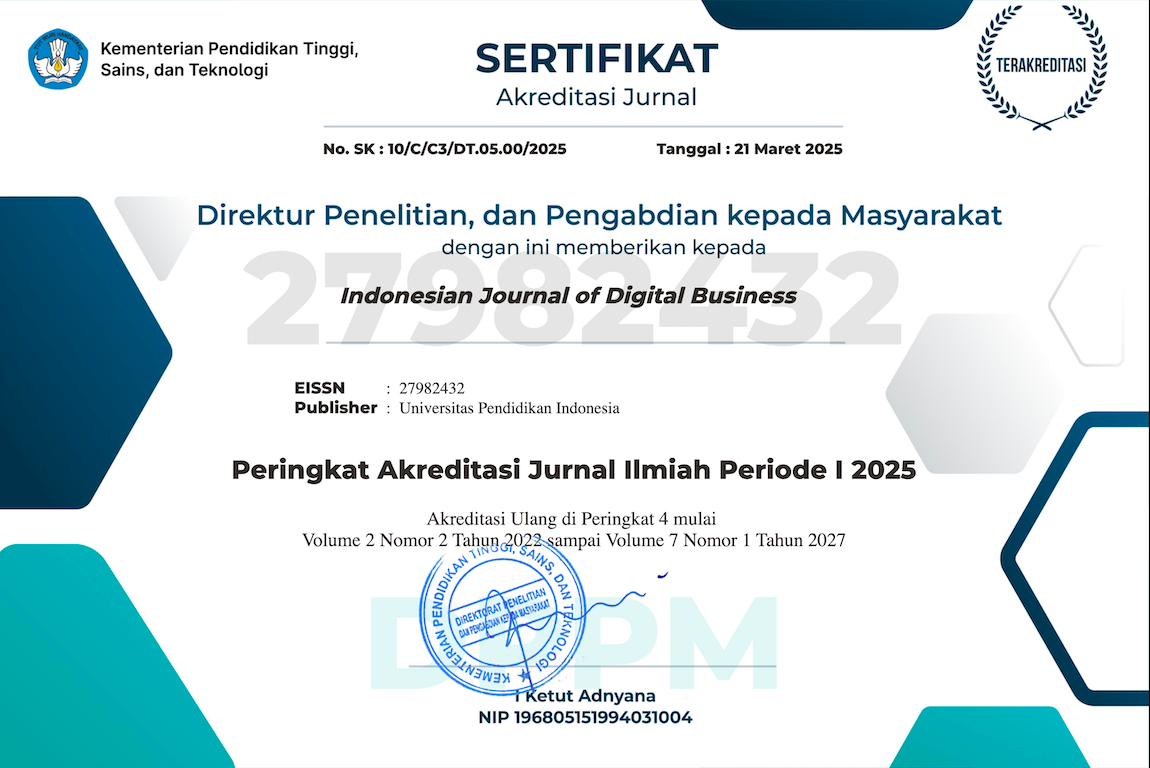Customer Indecisiveness pada E-Commerce Indonesia: Peran Price Sensitivity, Product Involvement, Risk, dan Social Inference
Abstract
Keywords
Full Text:
PDFReferences
Al Adwan, A. S., Al Debei, M. M., & Dwivedi, Y. K. (2022). E commerce in high uncertainty avoidance cultures: The driving forces of repurchase and word of mouth intentions. Technology in Society, 71, 102083. https://doi.org/10.1016/j.techsoc.2022.102083
Baabdullah, A. M., Alalwan, A. A., Algharabat, R. S., Metri, B., & Rana, N. P. (2022). Virtual agents and flow experience: An empirical examination of AI powered chatbots. Technological Forecasting and Social Change, 181, 121772. https://doi.org/10.1016/j.techfore.2022.121772
Cai, X., Cebollada, J., & Cortiñas, M. (2023). Impact of seller and buyer created content on product sales in the electronic commerce platform: The role of informativeness, readability, multimedia richness, and extreme valence. Journal of Retailing and Consumer Services, 70, 103141. https://doi.org/10.1016/j.jretconser.2023.103141
Chen, H., Li, H., & Pirkkalainen, H. (2024). How extended reality influences e commerce consumers: A literature review. Electronic Commerce Research and Applications, 50, 101404. https://doi.org/10.1016/j.elerap.2024.101404
Cui, X., Li, Y., Li, X., & Fang, S. (2023). Livestream e commerce in a platform supply chain: A product fit uncertainty reduction perspective. International Journal of Production Economics, 258, 108796. https://doi.org/10.1016/j.ijpe.2022.108796
Ding, R., Chen, X., Wei, S., & Wang, J. (2025). What drives trust building in live streaming E commerce? From an elaboration likelihood model perspective. Industrial Management & Data Systems, ahead-of-print. https://doi.org/10.1108/IMDS-01-2024-0012
Dost, F., Wilken, R., Eisenbeiss, M., & Skiera, B. (2014). On the edge of buying: A targeting approach for indecisive buyers based on willingness to pay ranges. Journal of Retailing, 90(3), 393–407. https://doi.org/10.1016/j.jretai.2014.03.007
Hanna, R. C., Lemon, K. N., & Smith, G. E. (2019). Is transparency a good thing? How online price transparency and variability can benefit firms and influence consumer decision making. Business Horizons, 62(2), 227–236. https://doi.org/10.1016/j.bushor.2018.10.002
Helmi, A., Komaladewi, R., Sarasi, V., & Yolanda, L. (2023). Characterizing young consumer online shopping style: Indonesian evidence. Sustainability, 15(5), 3988. https://doi.org/10.3390/su15053988
Hong, I. B., & Cha, H. S. (2013). The mediating role of consumer trust in an online merchant in predicting purchase intention. International Journal of Information Management, 33(6), 927–939. https://doi.org/10.1016/j.ijinfomgt.2013.05.007
Huwaida, L. A., Yusuf, A., Satria, A. N., Darmawan, M. A., Ammar, M. F., Yanuar, M. W., ... & Yaiprasert, C. (2024). Generation Z and Indonesian Social Commerce: Unraveling key drivers of their shopping decisions. Journal of Open Innovation: Technology, Market, and Complexity, 10(2), 100256. https://doi.org/10.3390/joitmc100200256
Jia, H., Shin, S., & Jiao, J. (2022). Does the length of a review matter in perceived helpfulness? The moderating role of product experience. Journal of Research in Interactive Marketing, 16(2), 221–236. https://doi.org/10.1108/JRIM-05-2021-0066
Kembau, A. S., & Lendo, F. B. (2025, Mei). Augmented Reality in Fashion and Beauty Product Marketing: A Preliminary Study of Immersive Marketing in Indonesian E Commerce. In 12th Gadjah Mada International Conference on Economics and Business (GAMAICEB 2024) (hlm. 379–395). Atlantis Press. https://doi.org/10.2991/978-94-6450-xxx
Kembau, A. S., Kolondam, A., & Mandey, N. H. J. (2024). Virtual Influencers and Digital Engagement: Key Insights from Indonesia's Younger Consumers. Jurnal Manajemen Pemasaran, 18(2), 123–136. https://doi.org/10.9744/pemasaran.18.2.123-136
Kembau, A. S., Laimeheriwa, I. B., & Kumaat, A. P. (2024). The Synergistic Effect of AR Interactivity and Personalization on Consumer Behavior in E Commerce. JMBI UNSRAT (Jurnal Ilmiah Manajemen Bisnis dan Inovasi Universitas Sam Ratulangi), 11(2), 1382–1391. https://doi.org/10.35794/jmbi.v11i2.57176
Kembau, A. S., Malae, F. E., & Lendo, F. B. (2024). Management Strategies to Reduce User Switching Behavior: Analyzing Critical Factors in Augmented Reality Technology Usage in E commerce. Business Management Journal, 20(2), 197–211. http://dx.doi.org/10.30813/bmj.v20i2.6013
Li, Z., Liu, J., Chen, J., & Zhang, Y. (2025). Why consumers hesitate to pay online: Evidence from online transactions. Australian Journal of Management, ahead-of-print. https://doi.org/10.1177/03128962241312715
Lu, B., & Chen, Z. (2021). Live streaming commerce and consumers’ purchase intention: An uncertainty reduction perspective. Information & Management, 58(7), 103509. https://doi.org/10.1016/j.im.2021.103509
Ma, X., Zou, X., & Lv, J. (2022). Why do consumers hesitate to purchase in live streaming? A perspective of interaction between participants. Electronic Commerce Research and Applications, 55, 101193. https://doi.org/10.1016/j.elerap.2022.101193
Monroe, K. B. (1990). Pricing: Making profitable decisions (2nd ed.). McGraw-Hill. (Buku teks, DOI tidak tersedia)
Munichor, N., & Cooke, A. D. J. (2022). Hate the wait? How social inferences can cause customers who wait longer to buy more. Frontiers in Psychology, 13, 990671. https://doi.org/10.3389/fpsyg.2022.990671
Roethke, K., Klumpe, J., Adam, M., & Benlian, A. (2020). Social influence tactics in e commerce onboarding: The role of social proof and reciprocity in affecting user registrations. Decision Support Systems, 131, 113268. https://doi.org/10.1016/j.dss.2020.113268
Sanak Kosmowska, K. (2021). Evaluating social media marketing: Social proof and online buyer behaviour. Routledge. (Buku teks, DOI tidak tersedia)
Shahab, M. H., Ghazali, E., & Mohtar, M. (2021). The role of elaboration likelihood model in consumer behaviour research and its extension to new technologies: A review and future research agenda. International Journal of Consumer Studies, 45(4), 664–679. https://doi.org/10.1111/ijcs.12673
Sundjaja, A. M., Tatuil, A. V., Scholus, D. V., & Restiani, Y. D. (2024). The determinant factors of shopping cart abandonment among e commerce customers in Indonesia. CommIT Journal, 18(1), 29–38. https://doi.org/10.21512/commit.v18i1.10797
Susanto, P., Hoque, M. E., Nisaa, V., Islam, M. A., & Kamarulzaman, Y. (2023). Predicting m commerce continuance intention and price sensitivity in Indonesia by integrating expectation confirmation and post acceptance model. SAGE Open, 13(3), 21582440231188019. https://doi.org/10.1177/21582440231188019
Verma, S., & Yadav, N. (2021). Past, present, and future of electronic word of mouth (EWOM). Journal of Interactive Marketing, 53, 111–128. https://doi.org/10.1016/j.intmar.2021.04.003
Wang, Q., Zhang, W., Li, J., Mai, F., & Ma, Z. (2022). Effect of online review sentiment on product sales: The moderating role of review credibility perception. Computers in Human Behavior, 133, 107272. https://doi.org/10.1016/j.chb.2022.107272
Yadav, R., Giri, A., Chakrabarty, D., & Alzeiby, E. A. (2024). Understanding the consumers’ webrooming in retailing industry: An application of uses and gratification and uncertainty reduction theory. Technological Forecasting and Social Change, 206, 123509. https://doi.org/10.1016/j.techfore.2024.123509
We Are Social, & Meltwater. (2024). Digital 2024: Indonesia. We Are Social. Diakses dari: https://wearesocial.com/uk/digital-2024-indonesia
DOI: https://doi.org/10.17509/ijdb.v5i2.86161
Refbacks
- There are currently no refbacks.
Copyright (c) 2025 Universitas Pendidikan Indonesia (UPI)

This work is licensed under a Creative Commons Attribution-ShareAlike 4.0 International License.
Indonesian Journal of Digital Business is published by Universitas Pendidikan Indonesia (UPI)
and managed by Department of Digital Business
Jl. Dr. Setiabudi No.229, Kota Bandung, Indonesia - 40154
View My Stats





1.png)